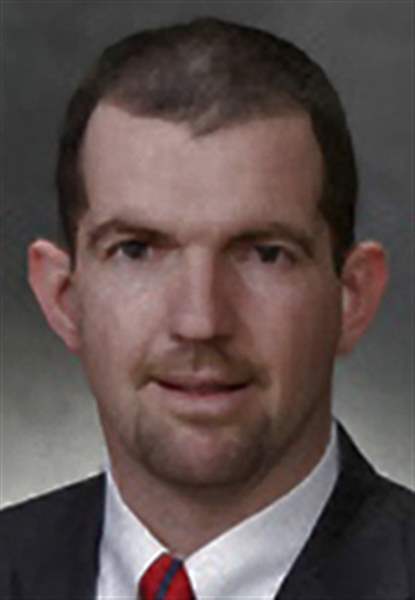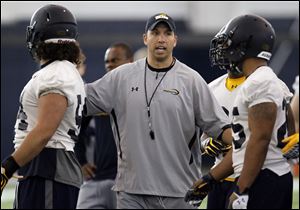
University of Toledo builds its defense one tall wingspan at time
New model focuses on adding size
8/25/2013
Matukewicz

.
If a defensive player wants to play for the University of Toledo, he should be prepared to be frisked.
At least he might think that’s what is happening.
“First thing when I see a recruit I say, ‘Hey, turn around. Put your arms up,’ ” defensive coordinator Tom Matukewicz said of the value he places on reach. “If that doesn’t look good, I don’t care what the film looks like. At the end of the day you’re going to miss a lot of plays.”
Aug. 31 at Florida, 12:20 p.m.
Sept. 7 at Missouri, 3:30 p.m.
Sept. 14 Eastern Washington, 7 p.m.
Sept. 21 at Central Michigan, noon
Sept. 28 at Ball State, 3 p.m.
Oct. 5 Western Michigan, 3 p.m.
Oct. 19 Navy, 7 p.m.
Oct. 26 at Bowling Green, TBA
Nov. 2 Eastern Michigan, 7 p.m.
Nov. 12 Buffalo, 7:30 p.m.
Nov. 20 Northern Illinois, 8 p.m.
Nov. 29 at Akron, TBA
Only once in the last 11 seasons has Toledo fielded a defense that finished in the top 50 nationally, an epidemic the new regime intends to cure by recruiting specific body types and skill sets. Backs are getting taller, linemen more explosive, and linebackers must possess expansive wingspans. The implication made by Matukewicz and head coach Matt Campbell in their formula is a departure from the past when coaches brought in talented players with little regard for how their skills meshed with the system.
Campbell and Matukewicz like to talk about the need to find 22 pieces — starters and backups — to form a puzzle.
“Kind of like what we’ve done on offense,” Campbell said. “We’ve recruited who we want to be offensively. Now we’re doing the same thing on defense.”
Toledo, which opens Campbell’s second season in six days at No. 10 Florida, will be young on defense. Stocked with guys brought in to fit the new model, the two-deep depth chart consists of 11 first or second-year players. In other words, 2013 and 2012 recruits make up half of the staff’s magic number of 22. Six are linemen and four are defensive backs.
Those numbers could foretell yet another year in which a struggling defense threatens to undermine a powerful offense. It appears Toledo’s offense, which returns nine starters, can’t afford to have sub 30-point efforts for the team to be successful.
“But now you see it,” Campbell said. “It looks right. We’re still young. We’re still going to have to grow it this season, but we’re creating depth across our defense.”
Campbell said the new era of tackles will resemble freshman starter Marquise Moore. That means “big physical guys who are just not going to get moved out of there.” Defensive ends will have the versatility to play outside linebacker and pressure the quarterback from an upright stance.
The most obvious change will be in the secondary.

Matukewicz
The staff does not recruit cornerbacks or safeties, Matukewicz said. They recruit defensive backs, and the bigger ones play safety. And most of them are fairly big. Seven of the nine defensive backs brought in the last two classes are 6 feet or taller, with the lone exceptions — safeties Danny Larkins and Travis Nees — standing 5-11. The 2014 class has commitments from two defensive backs, both of whom stand at least 6 feet.
Shorter cornerbacks transferred (Keith Suggs, 5-10) or switched to offense (Kishon Wilcher, 5-8). It won’t register as a surprise if the 5-9 Chris Dukes loses his starting job once a true freshman such as Jordan Martin (6-2) or DeJuan Rogers (6-1) gets comfortable.
“You have to shrink passing lanes today,” Campbell said. “You can’t be sitting in zone defenses and let people pick you apart. You have to be able to condense those zones. We want to recruit guys who are long and are able to get in passing lanes just by body structure.”
UT’s pass defense of late, to be blunt, has been awful. During the last four seasons the Rockets ranked on average No. 100 and never were better than No. 86. A year ago they were No. 116, which Matukewicz attributes some to his not trusting a young secondary and ordering soft coverage.
Matukewicz notes the defense ranked No. 10 in the red zone and No. 25 in creating turnovers, so it wasn’t all bad. They stopped 12 of 17 fourth downs, ranking ninth. The 28.4 points UT yielded was its lowest total since 2006 (27.7).
“Where I come from it was never about stats, it was about what it took to win a game,” said Matukewicz, who worked with Jerry Kill at three stops before coming to Toledo. “You try to play tight coverage, and if you’re not that talented, your points are going to go up. Your average might come down because you’re going to be closer on balls, but all of a sudden there’s 14 more points you’re going to give up.”
Matukewicz, for the first time in 15 seasons or so, will work from the coaches box and not on the field. He made the decision in the offseason after reflecting on moments last year when he didn’t react rationally to big plays by an opponent. Working in tranquility some 200 feet from the action, in theory, will insulate him from emotion.
“I thought that was one of the negatives I did last year,” he said.
An elevated view, Matukewicz said, will also help him to “put the pieces together.” Many of the pieces will be making their debuts Saturday. Experience levels of several others aren’t much higher. But as Campbell said earlier, the pieces finally look right.
“It’s kind of like an investment,” Matukewicz said. “If you had 100 grand, are you going to wing it out on something because it looked pretty, or are you going to do your homework and say this is what I’m looking for, this is how I’m going to invest my money? So if there’s a 5-8 corner, he may look pretty. He can go play for somebody else.”
Contact Ryan Autullo at: rautullo@theblade.com, 419-724-6160 or on Twitter @AutulloBlade.